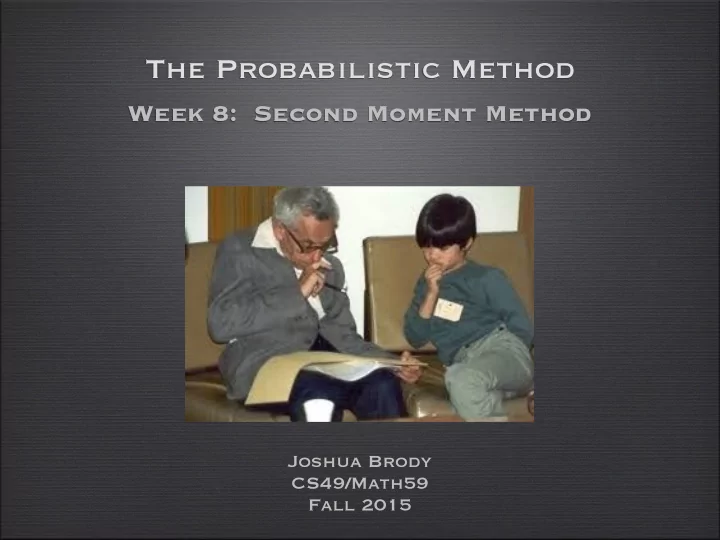

The Probabilistic Method Week 8: Second Moment Method Joshua Brody CS49/Math59 Fall 2015
Reading Quiz What is a graph property? (A) a set of graphs (B) a set of graphs closed under addition of edges (C) a set of graphs closed under addition of vertices (D) a set of graphs closed under isomorphism (E) None of the above
Reading Quiz What is a graph property? (A) a set of graphs (B) a set of graphs closed under addition of edges (C) a set of graphs closed under addition of vertices (D) a set of graphs closed under isomorphism (E) None of the above
The First Moment Method Basic Method: as First Moment Method: (1) Define bad events BAD i (1) Z i : indicator var for BAD i (2) BAD := ∪ i BAD i (2) Z := ∑ i Z i (3) E[Z i ] = Pr[BAD i ] ≤ 휹 (3) bound Pr[BADi] ≤ 휹 (4) Compute # bad events ≤ m (4) Compute # bad events ≤ m (5) union bound: (5) E[Z] = E[Z i ] ≤ m 휹 < 1 Pr[BAD] ≤ m 휹 < 1 (6) ∴ Z = 0 w/prob > 0 (6) ∴ Pr[GOOD] > 0
Exploiting Expected Value Suppose X is non-negative, integer random variable Fact: Pr[X > 0] ≤ E[X]
Exploiting Expected Value Suppose X is non-negative, integer random variable Fact: Pr[X > 0] ≤ E[X] Consequences: • If E[X] < 1 , then Pr[X=0] > 0 • If E[X] = o(1) , then Pr[X=0] = 1-o(1) • If E[X] → ∞ , then ???
More on The Second Moment Method Theorem: Pr[X = 0] ≤ Var[X]/E[X] 2 proof: • use Chebyshev’s Inequality with α : = E[X]
More on The Second Moment Method Theorem: Pr[X = 0] ≤ Var[X]/E[X] 2 proof: • use Chebyshev’s Inequality with α : = E[X] Consequences: • If Var[X] = o(E[X] 2 ) , then Pr[X=0] = o(1)
More on The Second Moment Method Theorem: Pr[X = 0] ≤ Var[X]/E[X] 2 proof: • use Chebyshev’s Inequality with α : = E[X] X > 0 “ almost always” Consequences: • If Var[X] = o(E[X] 2 ) , then Pr[X=0] = o(1)
More on The Second Moment Method Theorem: Pr[X = 0] ≤ Var[X]/E[X] 2 proof: • use Chebyshev’s Inequality with α : = E[X] X > 0 “ almost always” Consequences: • If Var[X] = o(E[X] 2 ) , then Pr[X=0] = o(1) • If Var[X] = o(E[X] 2 ) , then X ~ E[X] almost always.
Random Graphs [Erd ő s-Rényi 60] G ~ G(n,p) : random graph on n vertices V = {1, ..., n} each edge (i,j) ∈ E independently with prob. p G(n,p) : probability distribution G : random variable
Clicker Question When are A S and A T not independent? (A) S, T share at least one vertex (B) S, T share at least one edge (C) S, T share at least two vertices (D) (A) and (B) (E) (B) and (C)
Clicker Question When are A S and A T not independent? (A) S, T share at least one vertex (B) S, T share at least one edge (C) S, T share at least two vertices (D) (A) and (B) (E) (B) and (C)
The Probabilistic Method
Recommend
More recommend